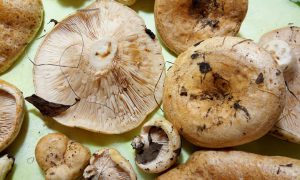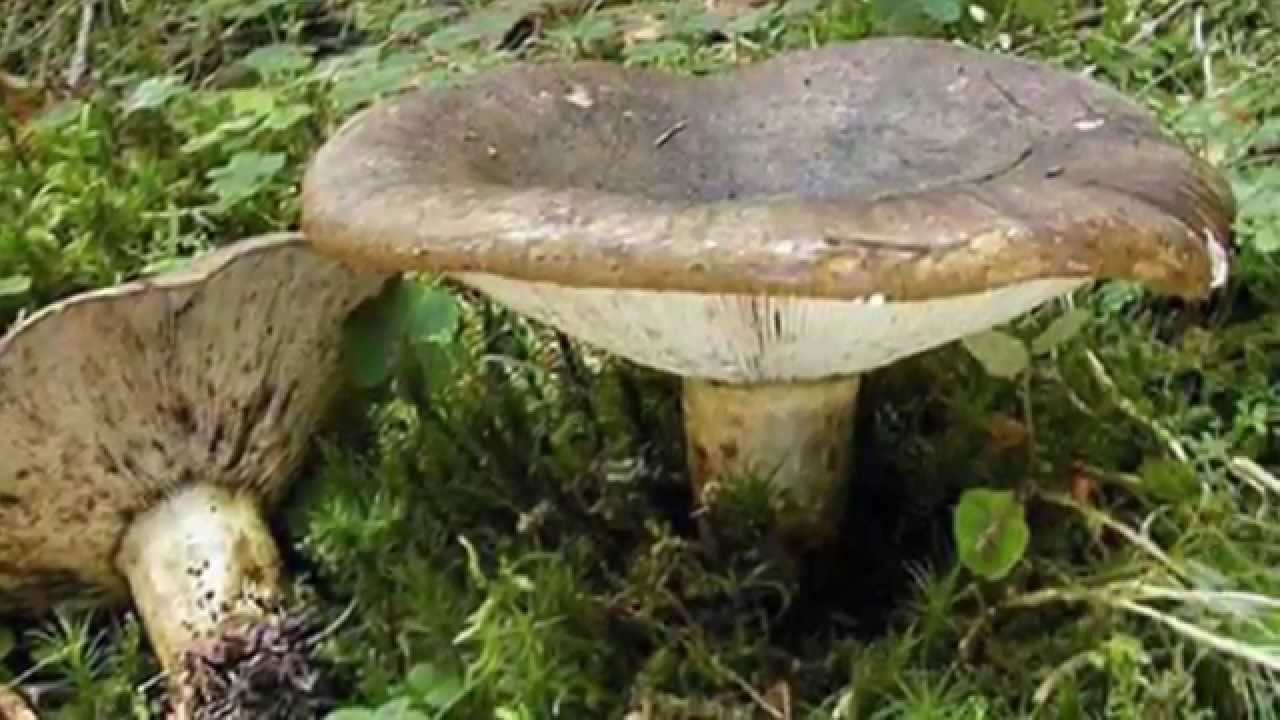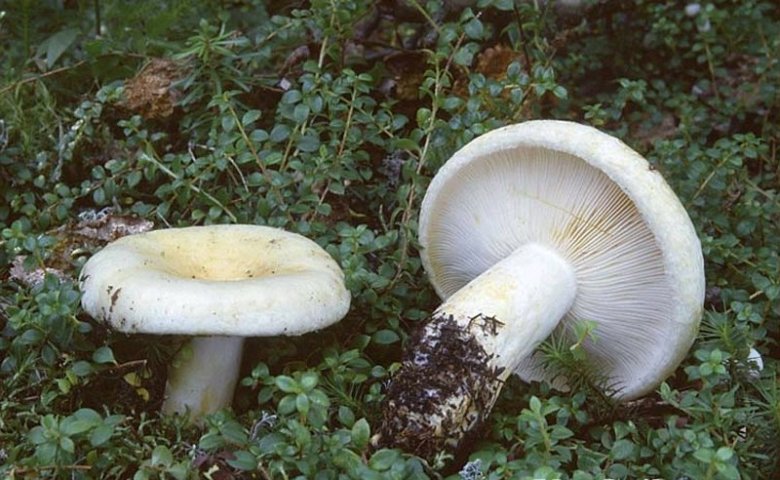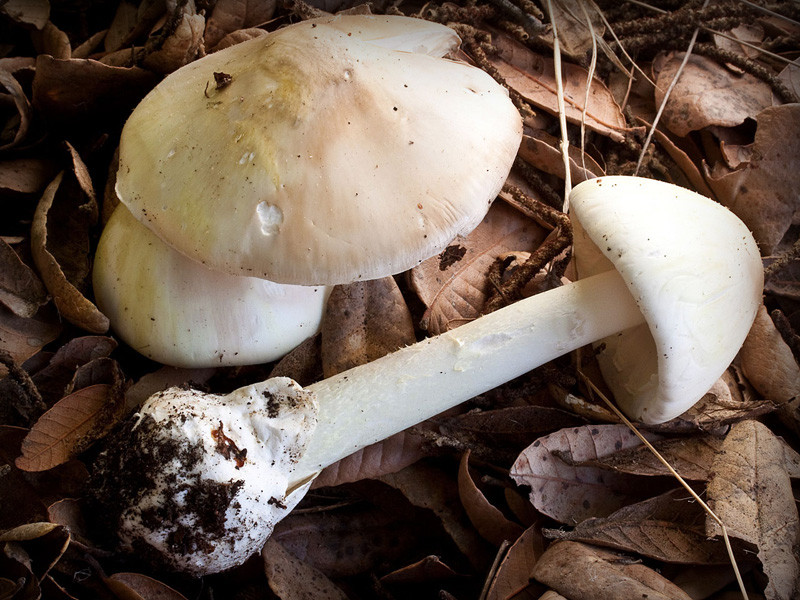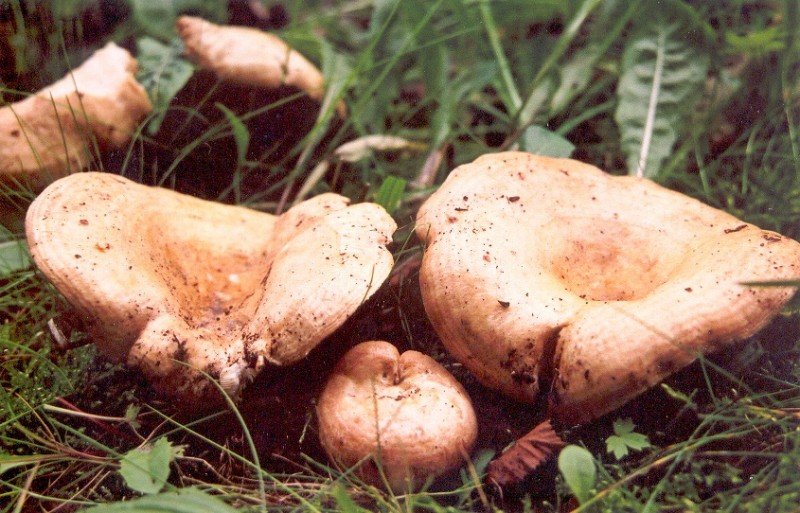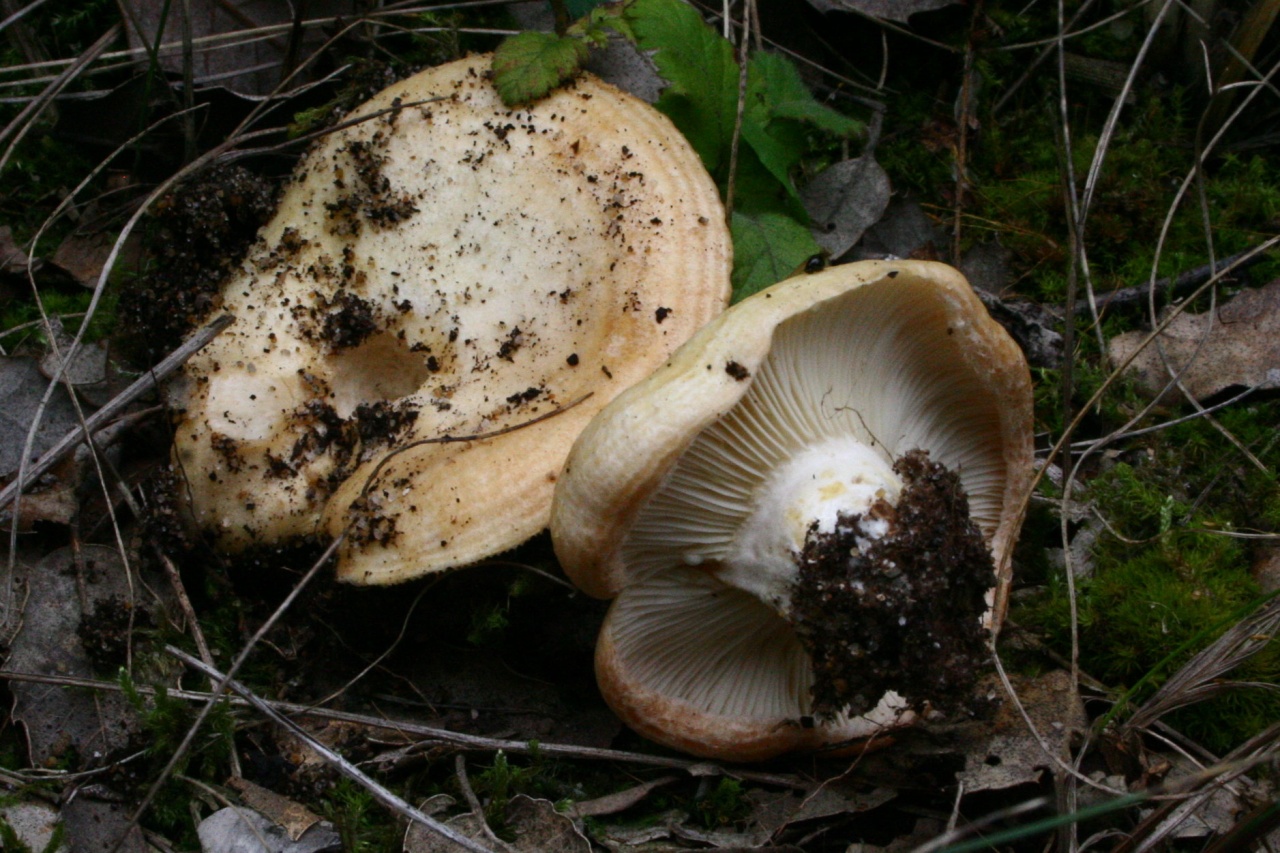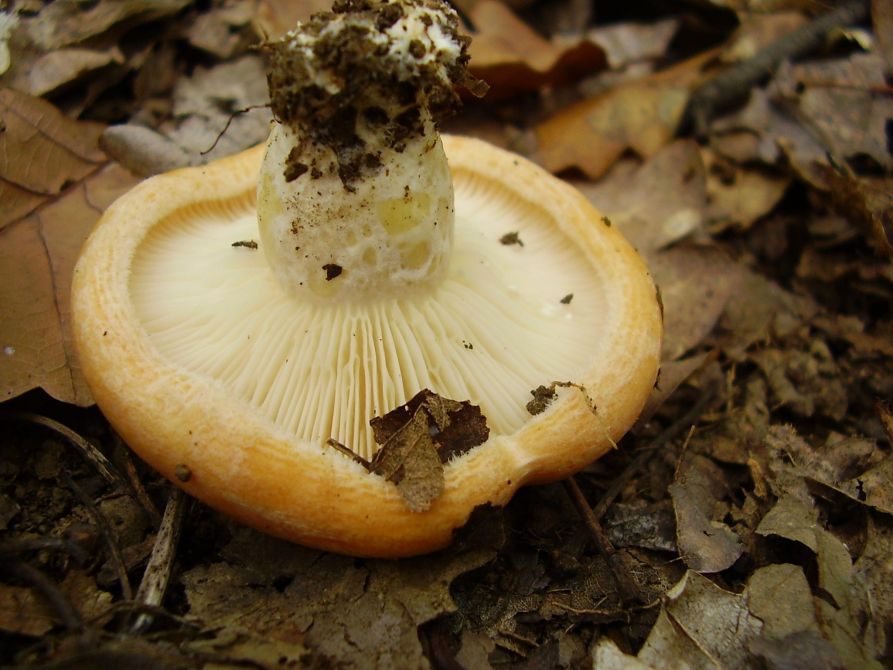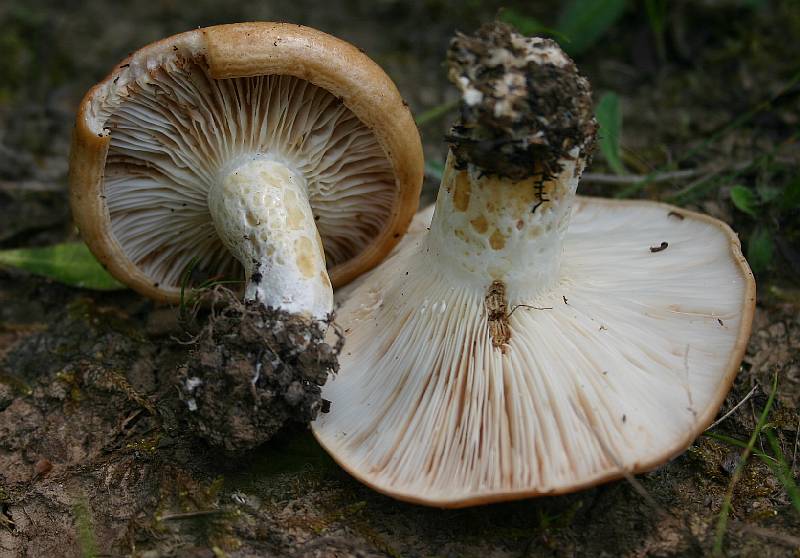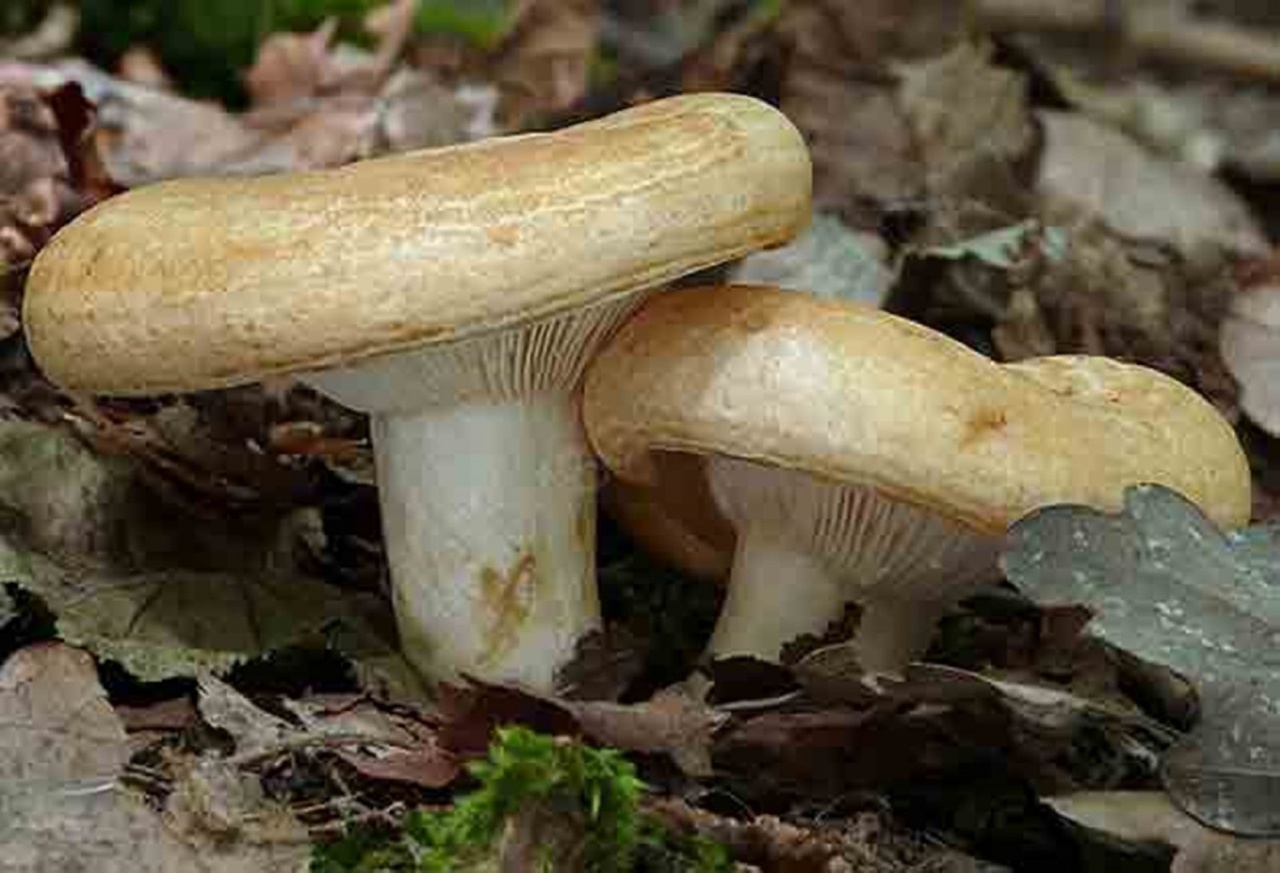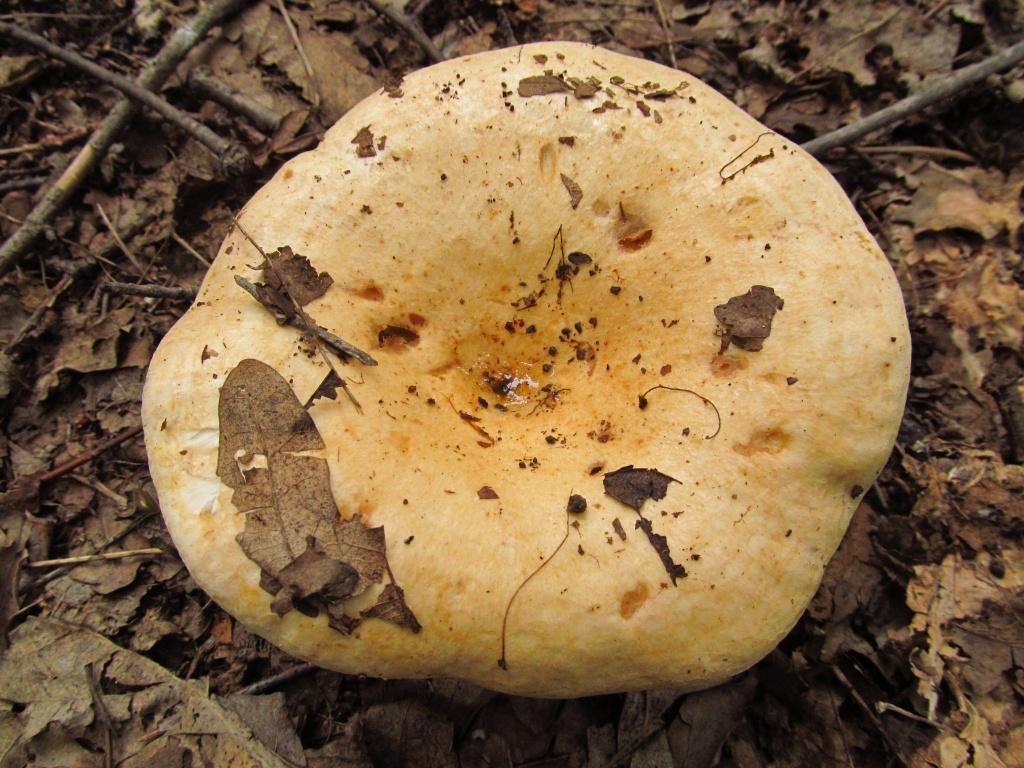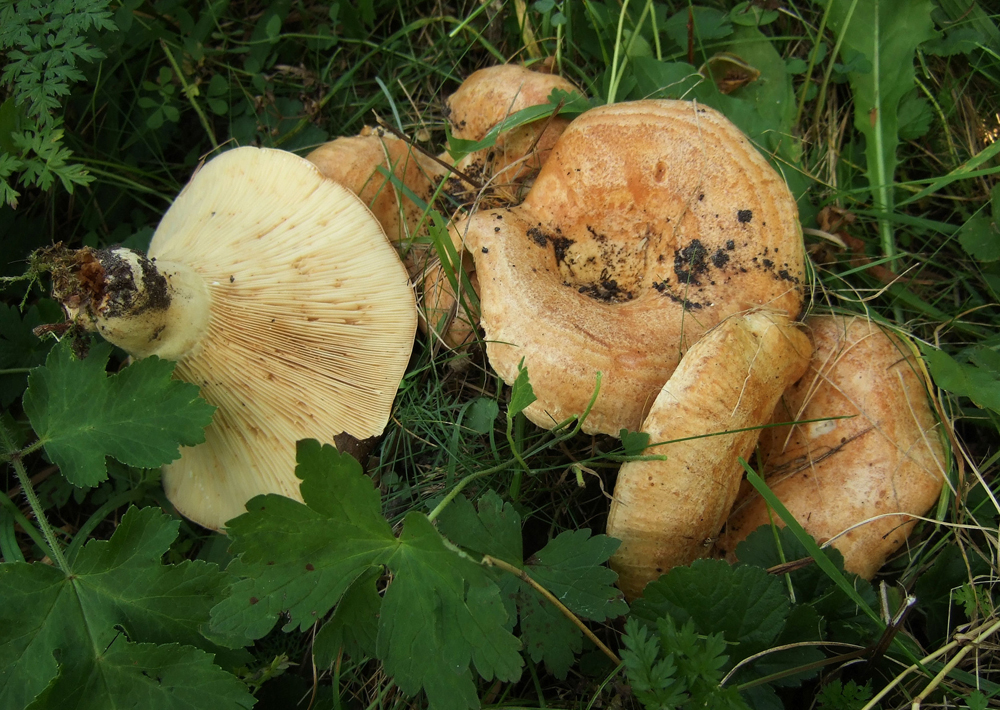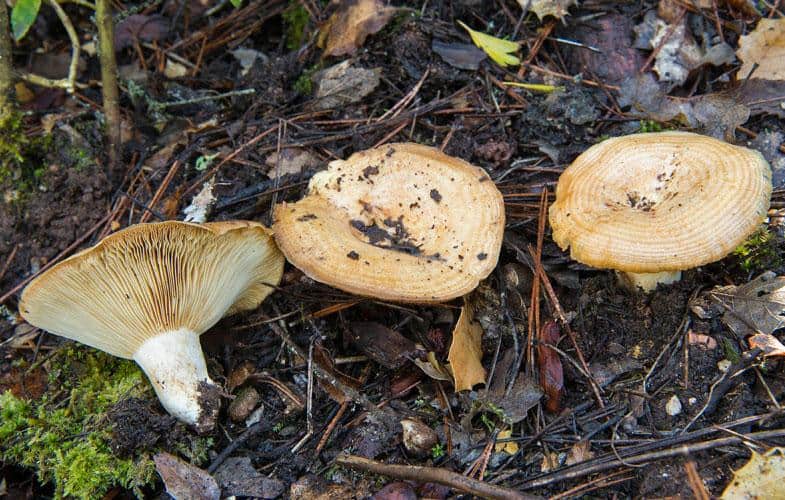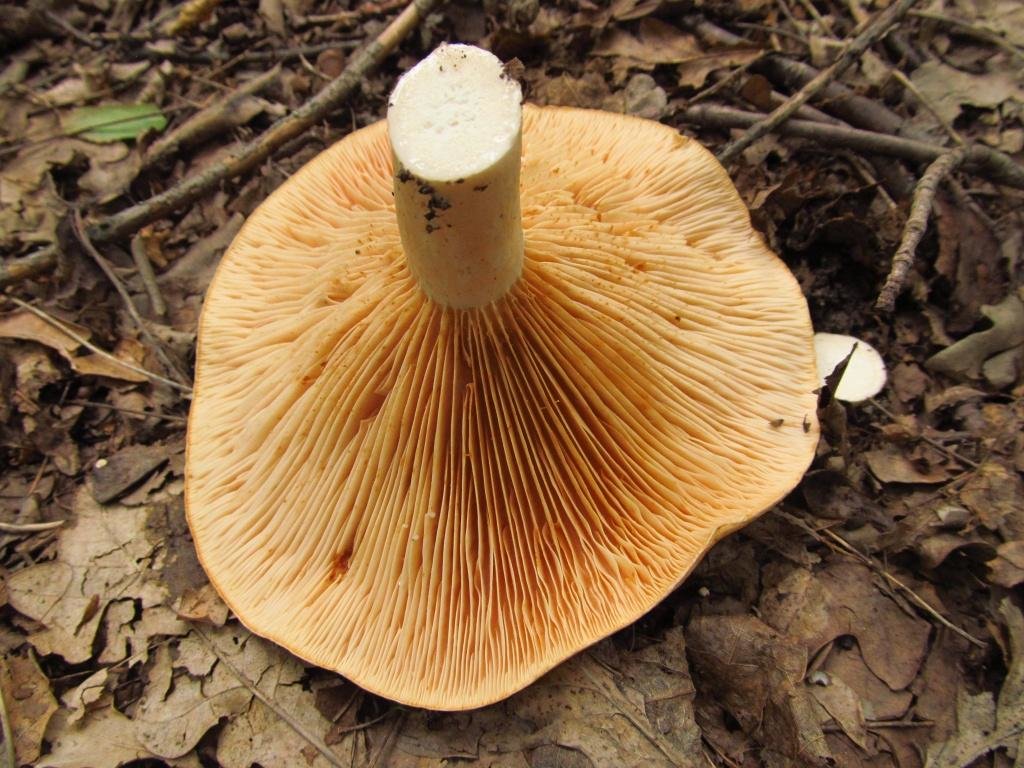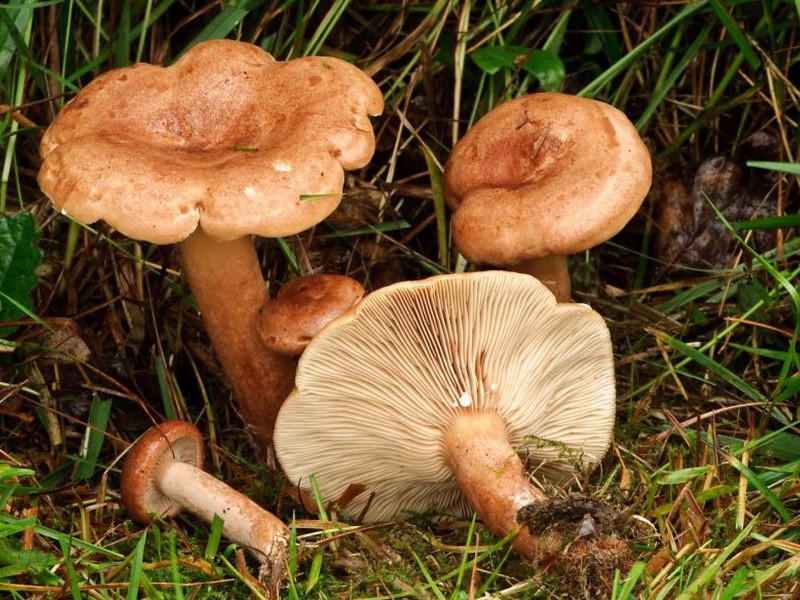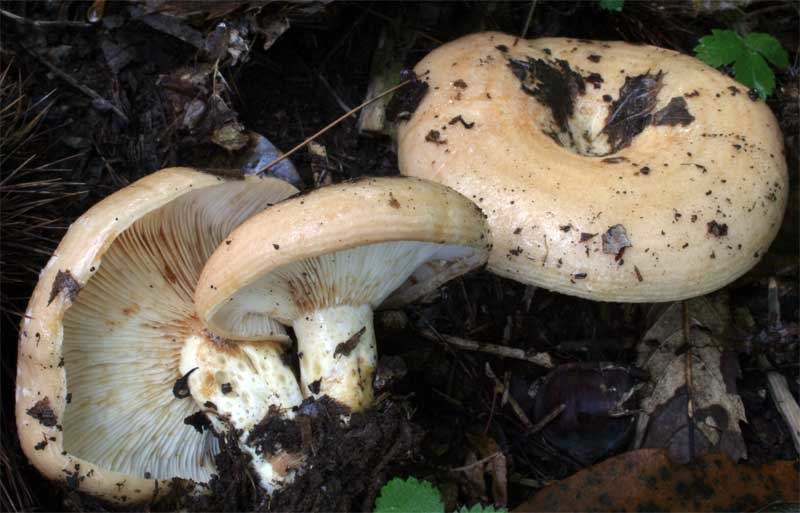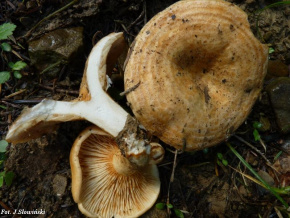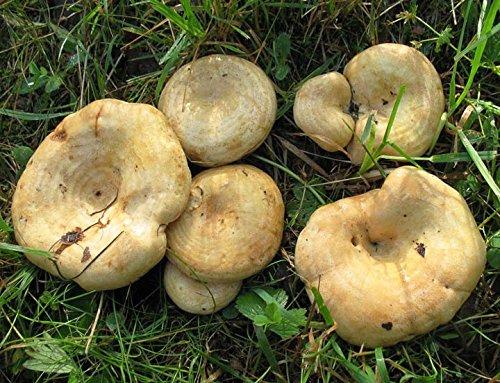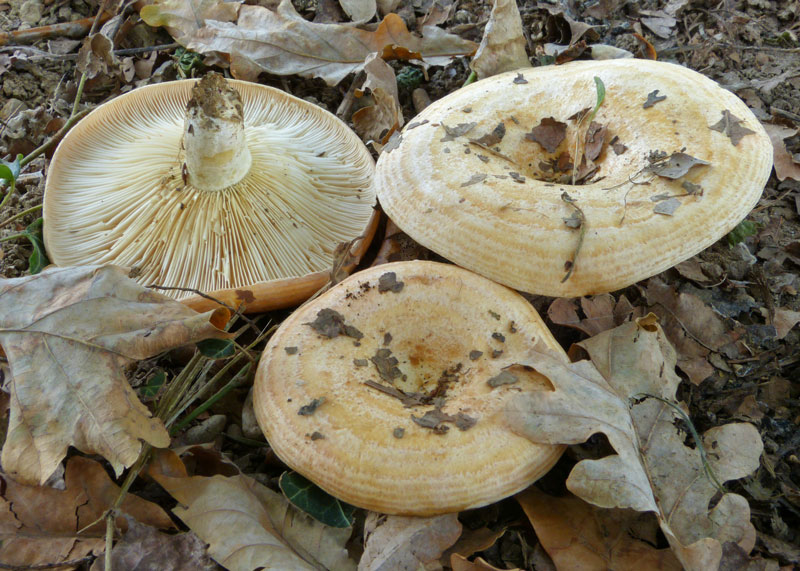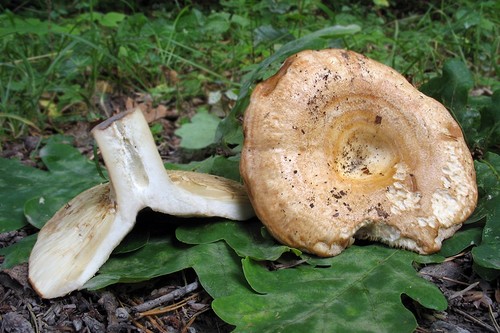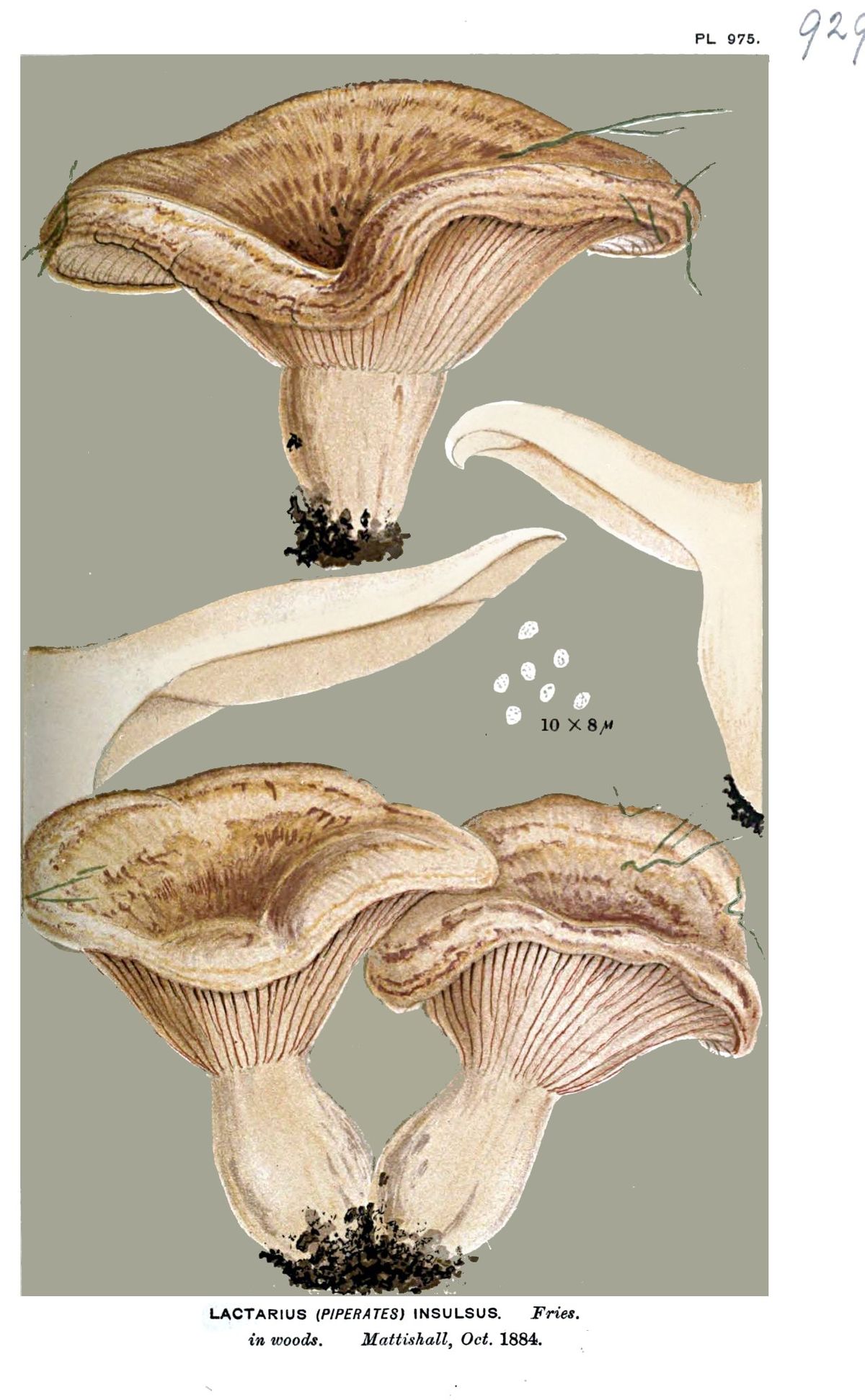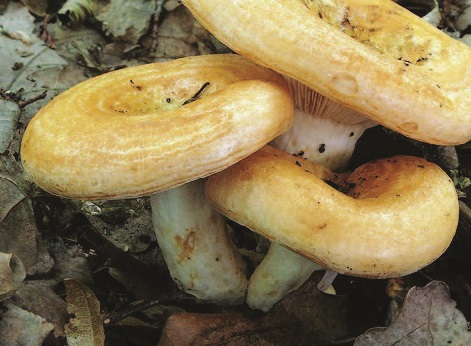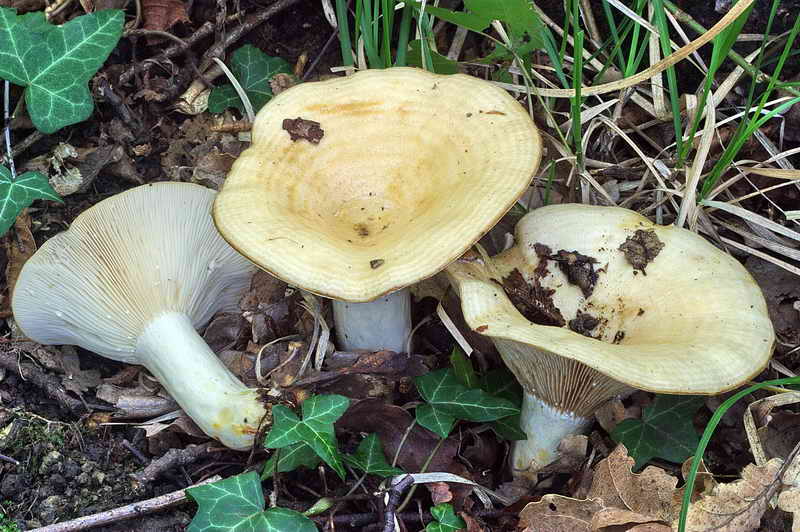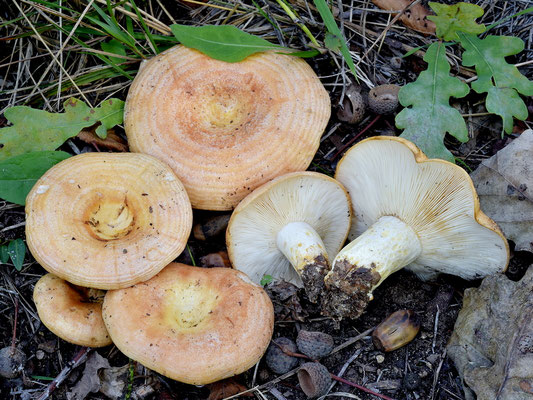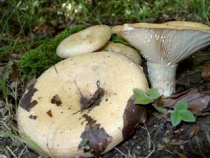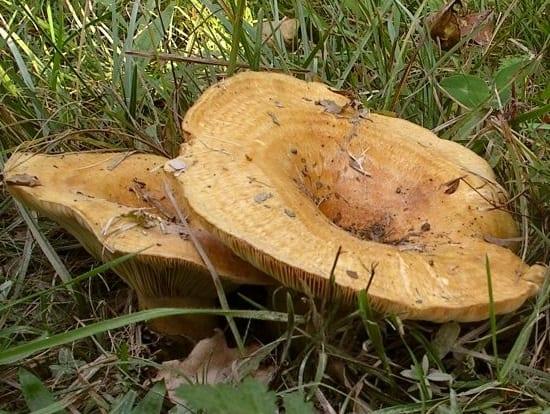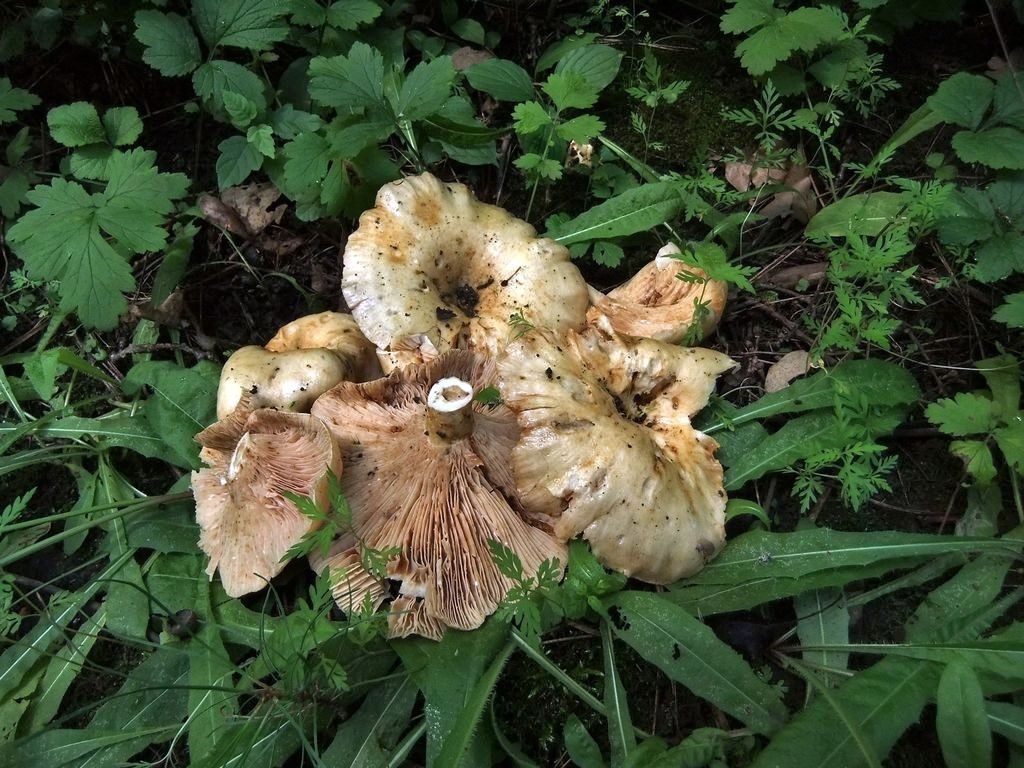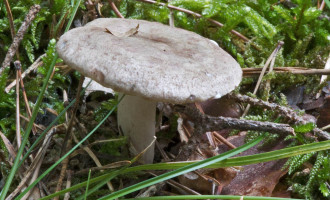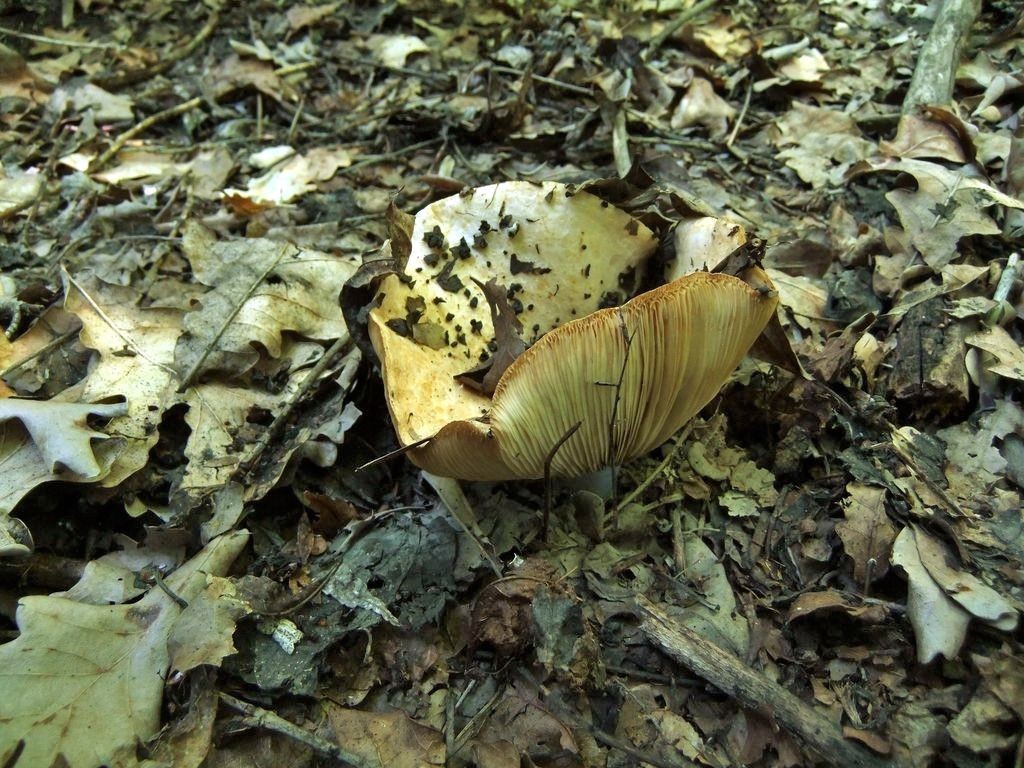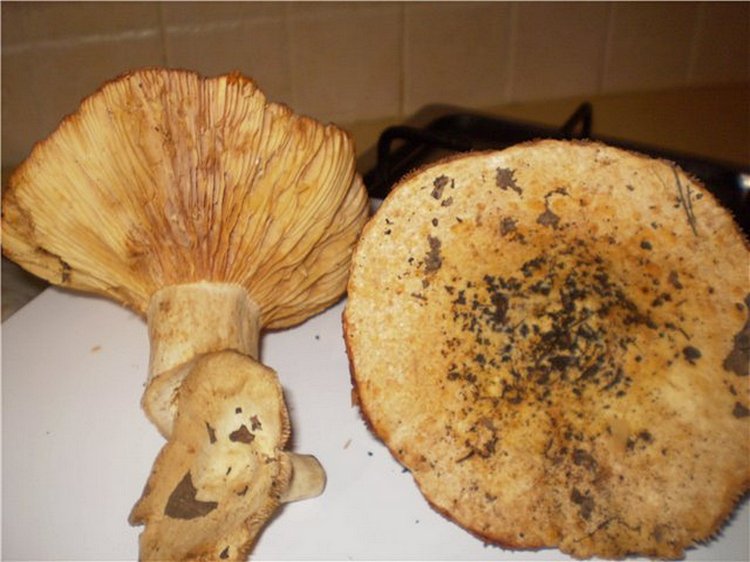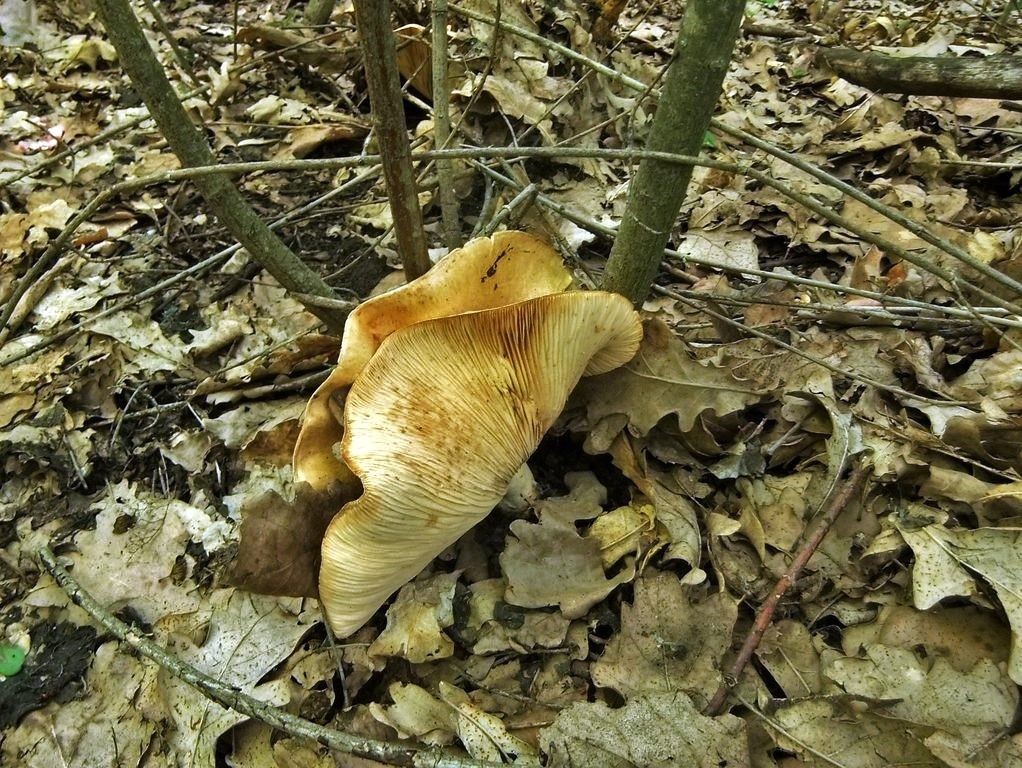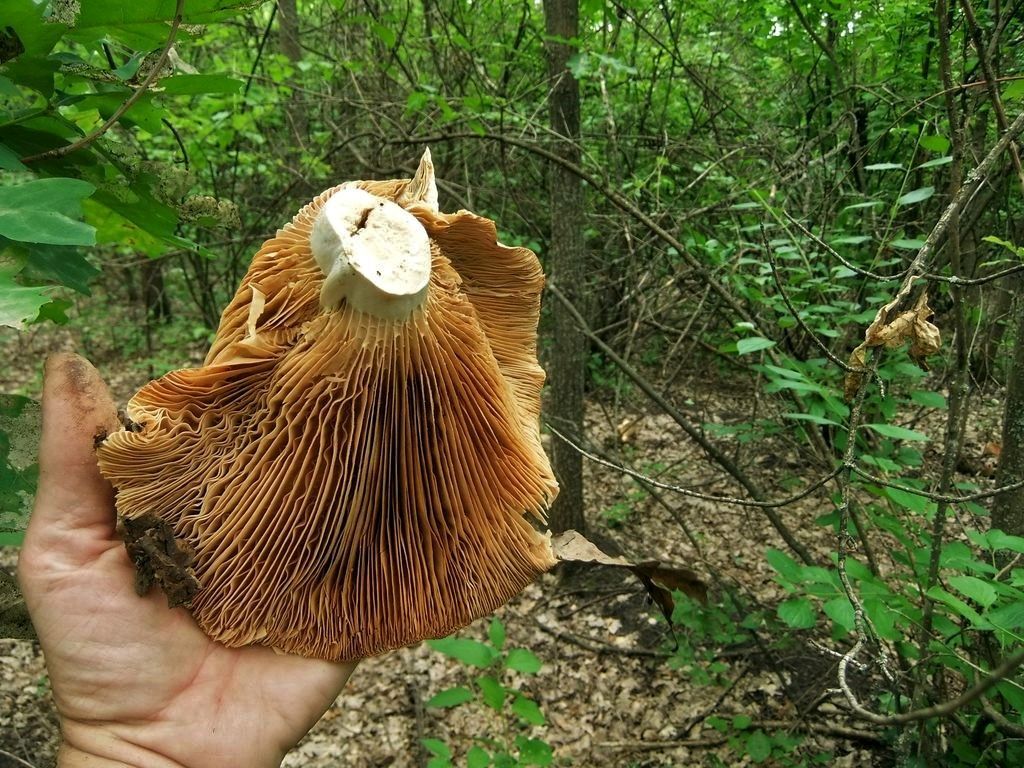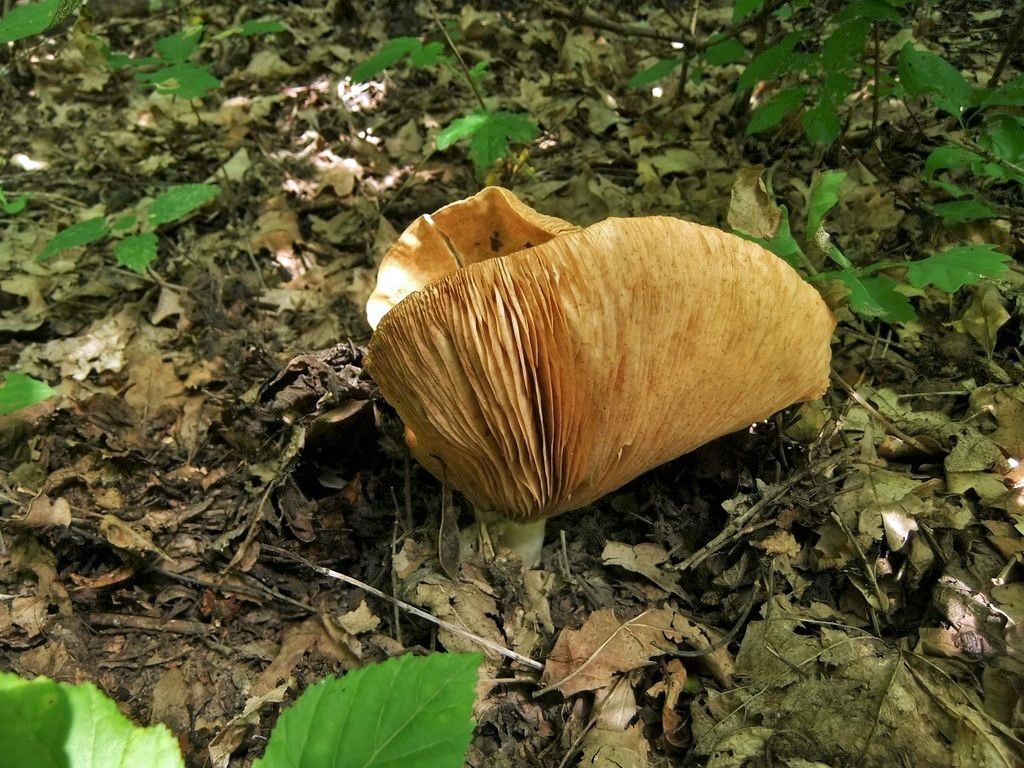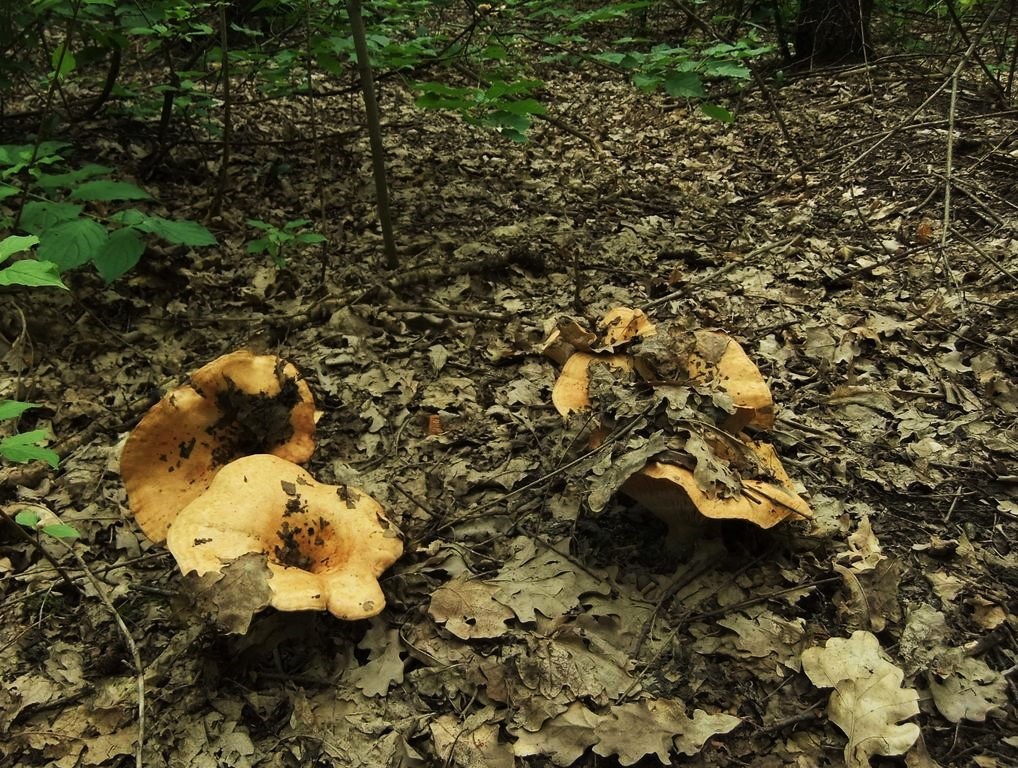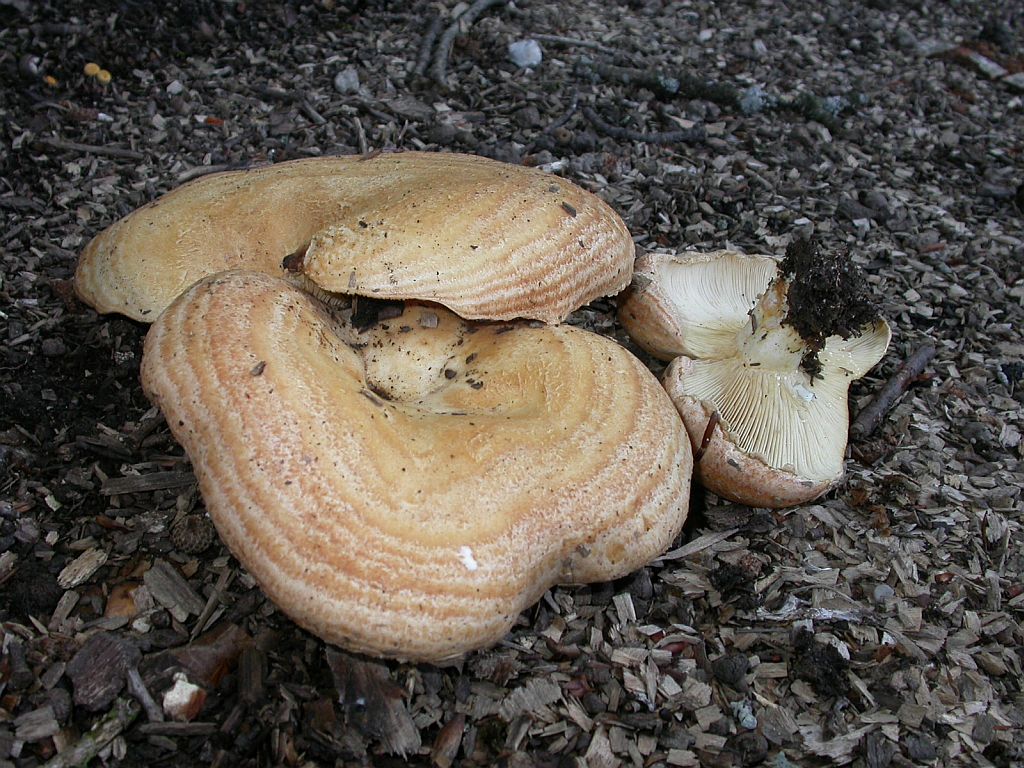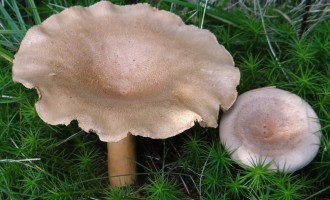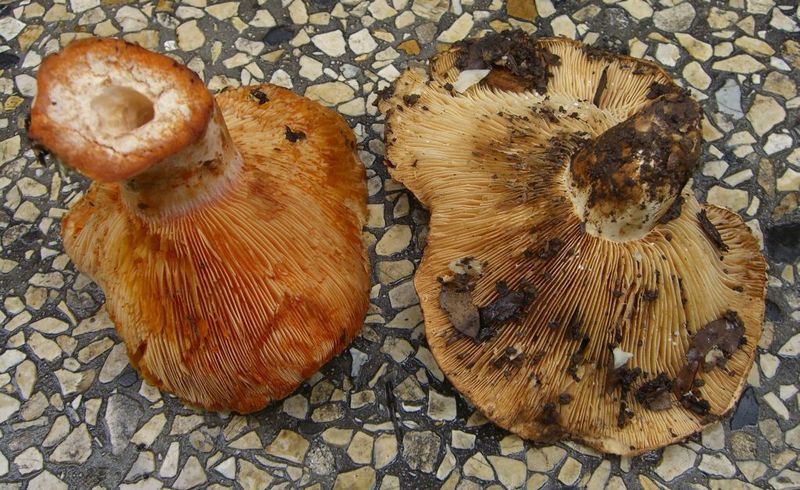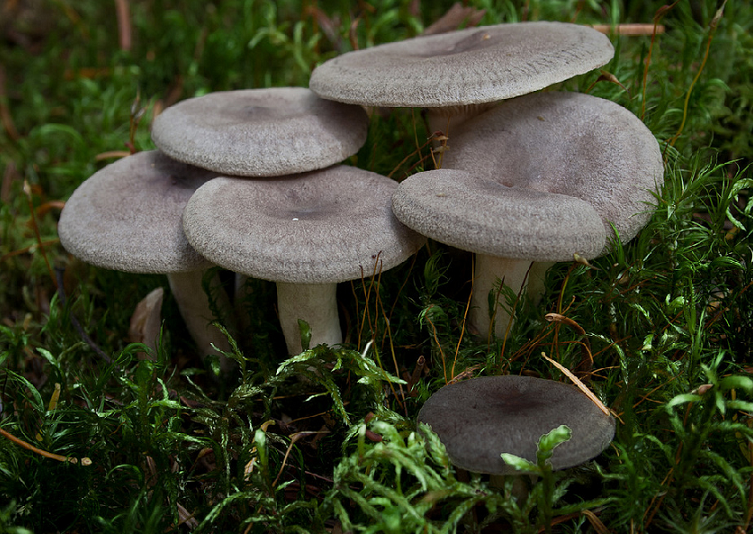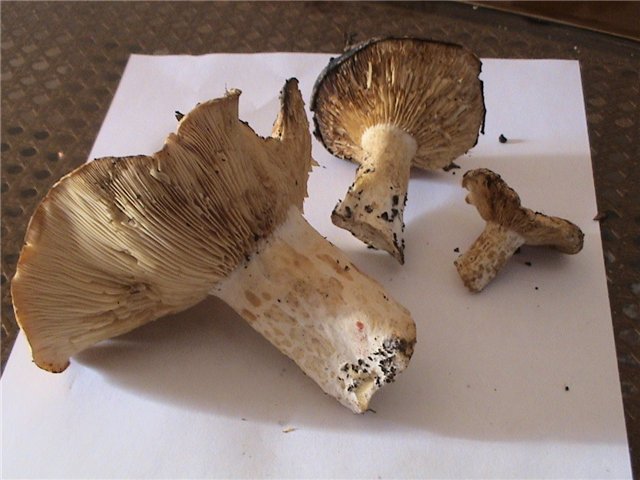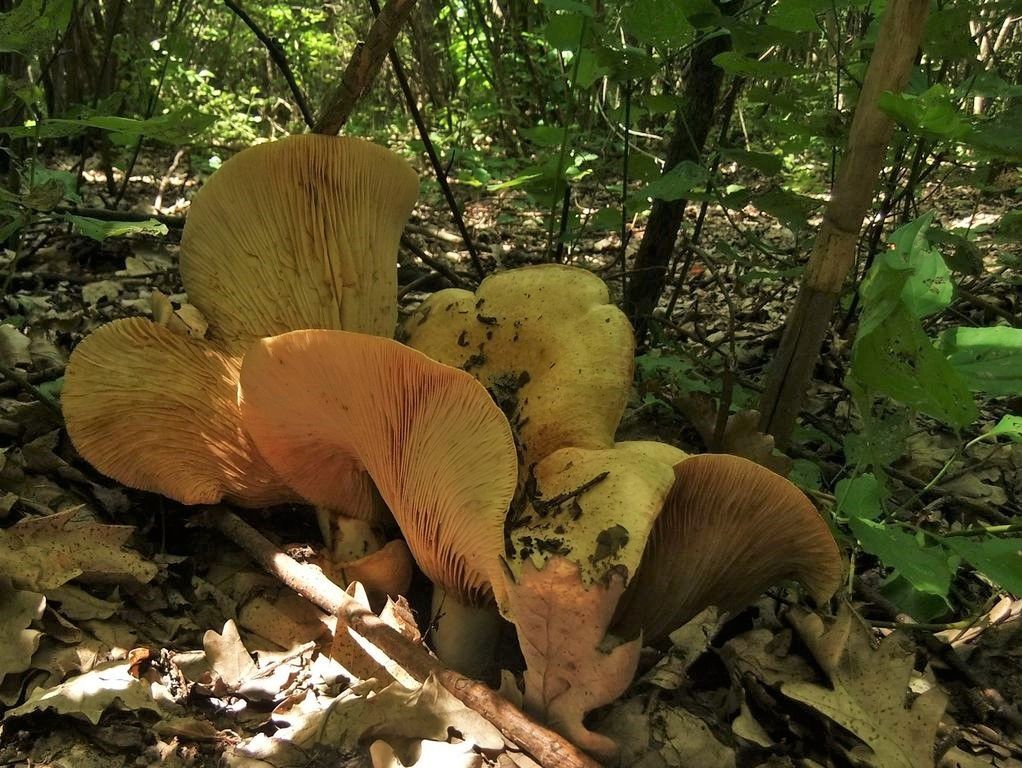Beneficial features
Highly nutritious fleshy mushrooms are rich in easily digestible proteins, carbohydrates, minerals and vitamins. The protein content in the fruit bodies is high - up to 33 g per 100 g of dry matter; in boiled form, they can be successfully used in dietary nutrition as a substitute for meat or fish.
B vitamins, carotene and ascorbic acid, which have a positive effect on the functioning of the nervous system, the stability of the immune system, and the work of hematopoietic organs, are significantly represented.
Mushrooms, unique in their kind, contain the active form of vitamin D, in a similar form it is found only in animal products. This essential element is essential for the prevention of osteoporosis, maintains healthy skin and hair, and directly affects the absorption and balance of calcium and phosphorus.
Minerals present in fungal tissues - sodium, magnesium, calcium and phosphorus - are in an accessible form, are quickly absorbed and replenish the content of these substances in the body.
Active antibacterial substances that inhibit tubercle bacillus have been found in the composition of the pepper milk mushroom; its positive effect in the treatment of kidney diseases, in particular, urolithiasis, is also known. These healing properties are widely used in traditional medicine.
During the preparation of pickled pickles, during fermentation with the participation of lactic acid, special substances are produced that have an anti-inflammatory effect and lower cholesterol levels.
Description
Milk mushrooms got their name in connection with the growth of large heaps ("heaps"). The oak lump looks about the same as the rest of this genus. It is distinguished only by its reddish color.
The caps of the mushrooms are quite wide, usually they are 15 cm in diameter, but there are specimens reaching 20 cm. The caps of small mushrooms are bent down, have a rounded shape with a sagging center. With growth, the breast opens up and its cap takes a funnel-shaped or arbitrary shape with slightly curved edges. The surface is dry (it can become damp only in rainy weather). Concentric patterns are visible on the cap, which have a darker color in comparison with the main one. The base color can vary from yellowish to brick.
Leg
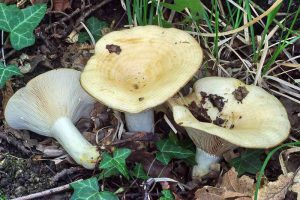 The leg of the mushrooms is thick (3-4 cm in diameter) and relatively short (no higher than 7 cm). The stem is cylindrical, often tapering downward. The leg has a cavity inside. The color of the leg of the weight repeats the color of its cap, but a little lighter. Dark spots may appear on the stem when it rains.
The leg of the mushrooms is thick (3-4 cm in diameter) and relatively short (no higher than 7 cm). The stem is cylindrical, often tapering downward. The leg has a cavity inside. The color of the leg of the weight repeats the color of its cap, but a little lighter. Dark spots may appear on the stem when it rains.
Spore-bearing layer
The lump has a lamellar hymenophore, which contains its spores. The plates are pale yellow to pink in color, darken in rain and brighten in dry weather.
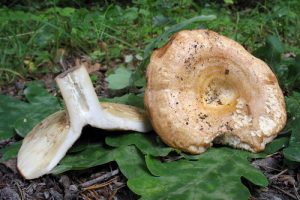 Pulp
Pulp
The pulp is fragile and hard, and may turn slightly pink when cut. The smell of a cut milk mushroom is reminiscent of a fruity aroma. The pulp gives off a small amount of whitish-milky acrid juice, which gives the mushroom an extremely bitter taste.
Description
The oak mushroom (Lactarius insulsus) belongs to the russula family, the genus Millechnikov. It is interesting that it has several Russian-language names and two Latin ones. Mycologists call it Lactarius zonarius or zonal milkman, and mushroom pickers call it oak mushroom or, due to the presence of white juice in the pulp, oak milkman. It belongs to the conditionally edible lamellar types of mushrooms.

- the cap is rather large, its diameter is 6-15 cm, however, some specimens manage to grow up to 20 cm.In young individuals, it has a convex shape with a distinct fossa in the middle and edges strongly curved inward, gradually takes on a flat-convex shape or immediately looks like a funnel. The edges are smooth, fleshy, slightly pubescent. In mature mushrooms, the cap is funnel-shaped and wide. The shape can often become irregular. The edges are thin, wavy, slightly tucked up.Young milk mushrooms may be wet to the touch, but in general, the cap of this species is dry, becoming sticky only in rainy weather. The skin color ranges from creamy yellow to reddish orange, sometimes brick red. On the cap there are clearly defined concentric circles of a darker shade than the main color of the mushroom. Usually the circles are brown;
- the leg is central, thick, short, up to 7 cm long and 1 to 3.5 cm thick. The shape of a straight cylinder, sometimes slightly tapering or thickening downwards. Thick but hollow inside. The color of the surface is usually close to the shade of the cap, but lighter - pinkish, whitish, cream. There may also be darker red spots on the stem - they often appear if the mushroom season is rainy;
- the pulp is dense, firm, but breaks easily. The color is whitish, cream, sometimes changing to pale pinkish at the cut. Has a pleasant fruit smell and a very bitter, pungent taste.
The bitter taste is caused by the watery milky juice that produces pulp when damaged. It is white, does not change its shade upon contact with air;
- plates slightly descending on the stem, rather frequent, wide, have a yellowish or pinkish-red color. By the way, depending on the age of the mushroom or the weather, they can change shade, becoming white, cream in dry weather, and darkening to a brown color in the rain;
- buffy spores.
Distribution and fruiting period
The oak lump prefers to settle in mixed, deciduous, deciduous forests, sometimes in pine plantations. Most of all he loves oak forests and is usually found next to oak trees - this explains the appearance of its name. Also, oak lump settles next to hornbeams, beeches, hazel, preferring to live on humus loams.

The oak mushroom often bears fruit in groups, but there are also single specimens. The season of active growth and development begins at the end of July and does not end until the end of September or early October.
They collect it in the fall, since in the middle of summer it is still underground, developing there. That is why his hat is usually very dirty.
Nowadays, oak mushroom is rare, although it used to grow almost everywhere and in large quantities.
Where the lump grows
White mushroom grows mainly in the northern regions, but occasionally it can also be found in other climatic regions. If you go on a "quiet hunt" for these particular mushrooms, you should know that they prefer to grow in deciduous and mixed forests, and they are most often found near birches, since the fungus forms mycorrhiza with the roots of this particular tree. It makes no sense to look for these mushrooms in more often, since they prefer wet and moderately lit meadows, glades and forest edges. Milk mushrooms are mushrooms with a slow growth rate (0.2-0.3 cm per day). It takes about a week for them to fully ripen.
Going into the forest for these mushrooms, you should also know that the peak of their fruiting occurs in late summer or early autumn (depending on the climatic region). But, if autumn is warm, they can be found in October as well. It should also be borne in mind that in hot weather, fruiting bodies develop poorly, therefore, it is better to go after prey with the onset of cool rainy weather.
Milk mushrooms love moist, mixed coniferous forests. Appear after heavy warm rains. Like all lamellas, they grow in families, and very quickly: a couple of days - and the "glade" is ready, you can collect it again. Milk grows in 3-5 days to medium size and continues to grow for 10-15 days
The diameter of the cap and the height of the mushroom per day increase by 1 -1.5 cm. Pay attention to the abandoned mows near the forest - often milk mushrooms grab the edge of the clearing.
To a decisive extent, the growth rate of mushrooms depends on the temperature and humidity of the soil and air. The most favorable temperature in the forest is about 22 ° C, and the humidity is 80-85%. Mushrooms do not like excessive humidity and hot weather. In warm, but not hot weather, they grow faster than in cold weather.A significant increase in the growth of fungi is noted after warm, quiet rains, the appearance of fogs. Low air humidity and dry soil cause their growth to stop. It also occurs as a result of infestation of fruit bodies with mosquito and fly larvae.
Consider in which regions of Russia milk mushrooms are most common:
- Many of these mushrooms grow in the Krasnoyarsk Territory. These are Arey, Emelyanovo, Uzhur, Kurtak, the vicinity of Uyar, Bartat, Shchetinkino.
- In the Chelyabinsk region, mushrooms can be found in the forest on the western side of Lake Bolshoy Kremenkul, in the forests along the Kyshtym-Ozersk highway, the surrounding Kasley forests are also rich in mushrooms, in the forests around the village of Kureinoe, in the forest around the village of Tomino.
- In the Vladimir region, the villages of Efimovskaya and Smykovo, the village of Demukhino, Ilyino, Muromtsevo (Sudogodsky district) are famous for their mushrooms. The village of Pervomaisky (Selivanovsky district), Boldino (Sobinsky district) in the direction of Koloksha.
- In Transbaikalia, milk mushrooms grow in the Tunkinskaya Valley, not far from Irkutsk in the village of Pivovarikha.
- The southeast of the Sverdlovsk region is ideal for picking milk mushrooms. In the north of the Middle Urals, there are also milk mushrooms, but in smaller quantities, and not everyone will follow them into the deep taiga. Excellent places near the stations Reshety, Sportivnaya, Novoalekseevskaya, near Kamyshlov.
 Collected milk mushrooms
Collected milk mushrooms
An excerpt characterizing the Oak Milk
Milk mushrooms are widespread in Russia. Most often they can be found in the Urals and Siberia. Westerners believe that these mushrooms should not be eaten, but they are wrong. In fact, milk mushrooms are conditionally edible mushrooms, just the process of their preparation involves a lot of trouble.
Below you can find a photo and description of black mushrooms and other types of these mushrooms: oak, pepper and blue mushrooms.
Oak Burger Hat (Lactarius quietus) (diameter 3-9 cm):
brown or reddish, in a young mushroom it is usually almost flat, with time it becomes convex. The edges of the cap are sometimes curled towards the inside. Dry to the touch.
Leg (height 3-7 cm):
solid, in old mushrooms it is almost always hollow, cylindrical in shape. It does not differ in color from the cap, except that it is darker near the ground.
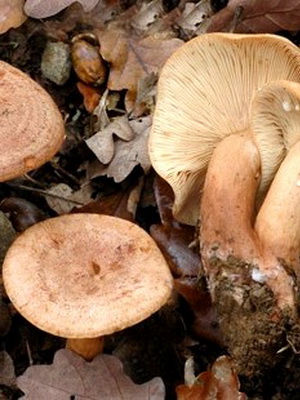
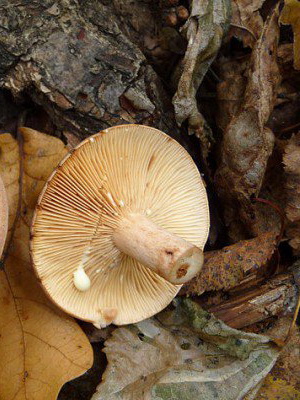
note in the photo of an oak milk:
its plates are frequent and narrow, very thin. Pulp:
brittle, white, turns pink at the cut site
When cut or broken, emits a pleasant scent of fresh hay
Pulp:
brittle, white, turns pink at the cut site. When cut or broken, it emits a pleasant scent of fresh hay.
Doubles:
sirushka (Lactarius flexuosus) and watery milky milky (Lactarius serifluus). But the hat of the serushka has a grayish tinge, and the lacquer has a pungent odor and the hat is much darker.
When it grows:
from mid-July to late September in the northern half of Europe.
Where can I find:
in mixed and deciduous forests, most often next to oak trees, as the name implies.
Eating:
suitable only for salting due to its low taste.
In the treatment of urolithiasis.
Other names:
the lactician is neutral, the lactician is oak, the lactician is calm.
Evaluation of taste, medicinal properties, benefits and possible harm
The mushroom is considered conditionally edible, the most commonly used salted. It belongs to the second group of edibility because of the pungent milky juice, the removal of which requires prolonged soaking before cooking. Also, this feature helps the mushroom to remain intact and not be eaten by worms.
In terms of taste, it is equated to black milk mushroom, as well as aspen and poplar. Like any mushrooms, pregnant women and nursing mothers do not eat them. Children under three years of age and people with diseases of the gastrointestinal tract, exacerbations of chronic liver and kidney problems are also poorly tolerated. Milk mushrooms are quite capable of replacing meat while maintaining a vegetarian diet.
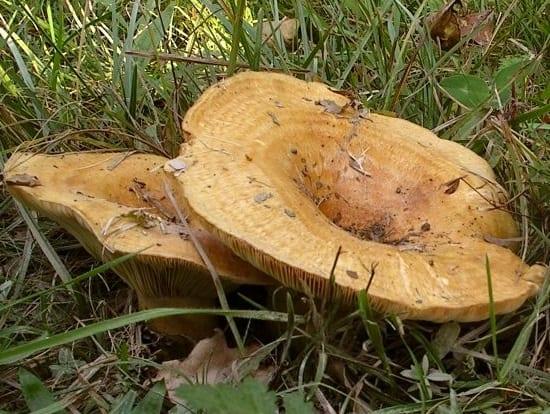 The content of a large amount of vitamins and various amino acids makes oak mushroom useful, it is completely absorbed by the body, and surpasses beef in protein content. This allows us to consider it a valuable food product, moreover, the ability not to raise blood sugar levels, makes it possible for diabetics to use it, helps to remove toxins from the body.
The content of a large amount of vitamins and various amino acids makes oak mushroom useful, it is completely absorbed by the body, and surpasses beef in protein content. This allows us to consider it a valuable food product, moreover, the ability not to raise blood sugar levels, makes it possible for diabetics to use it, helps to remove toxins from the body.
When salted milk mushrooms ferment, this process adds to the mushroom's ability to acquire anti-inflammatory properties, improve liver and gallbladder function, and also reduce the risk of kidney stones. The content of vitamin B helps relieve tension, calm the nervous system and get rid of neurosis and depression.
The mushroom is used by pharmacists to create drugs that help to cope with lung diseases, tuberculosis, emphysema. They are able to improve the condition of the hair and skin due to the high content of vitamin D. The milk mushroom is also widely used in folk medicine.
Fruit bodies collected in contaminated areas, near roads and garbage dumps, as well as industrial enterprises will be harmful.
When cooking, be sure to follow all necessary precautions
Milk papillary (Lactarius mammosus)
Names are considered synonyms:
- Papillary milky;
- The lump is large;
- Agaricus mammosus;
- The miller is large;
- Lactifluus mammosus.
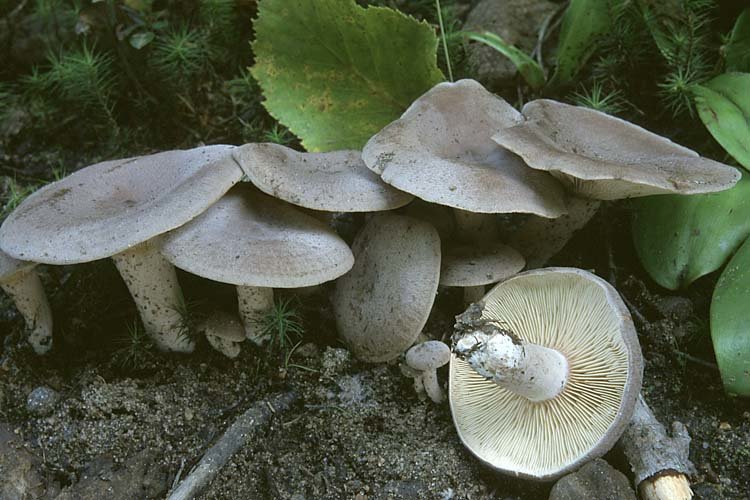
The papillary lactus (Lactarius mammosus) belongs to the genus Millechnikov, and in the scientific literature it is called the papillary lactic acid. Belongs to the russula family.
External description of the mushroom
The papillary milk mushroom, which is also known as the large milk mushroom, has a fruiting body with a cap and a leg. The diameter of the cap is 3-9 cm, it is characterized by a concave-spread or flat-spread shape, small thickness, combined with fleshiness. There is often a tubercle in the center of the cap. In young fruit bodies, the edges of the cap are bent, then they become open. The color of the mushroom cap can be bluish-gray, brown-gray, dark gray-brown, often has a purple or pink tint. In mature mushrooms, the cap burns out to a yellow color, becomes dry, fibrous, covered with scales. Fibers on its thin surface become visible to the naked eye.
The mushroom leg is characterized by a length of 3 to 7 cm, has a cylindrical shape and a thickness of 0.8-2 cm.In mature fruiting bodies, it becomes hollow from the inside, smooth to the touch, whitish in color, but in old mushrooms the shade becomes the same as in hats.
The seed part is represented by whitish spores of a rounded shape, with dimensions of 6.5-7.5 * 5-6 microns. The mushroom flesh at the cap is white, but darkens when the skin is removed. On the stem, the pulp is dense, with a sweetish aftertaste, brittle, has no aroma in fresh fruiting bodies. When dried mushrooms of this type, the pulp acquires a pleasant smell of coconut flakes.
The hymenophore of the papillary lactic acid is represented by the lamellar type. The plates are narrow in structure, are often located, have a whitish-fawn color, but in mature mushrooms they become red. They run down a little along the leg, but do not adhere to its surface.
Milky sap is characterized by a white color, does not flow too abundantly, does not change its color under the influence of air. Initially, the milky juice has a sweetish taste, then it becomes spicy or even bitter. Overripe mushrooms practically do not have it.
Habitat and fruiting period
The most active fruiting of the papillary lactarius occurs in the period from August to September. The fungus of this species prefers to grow in forests of coniferous and mixed types, as well as in deciduous forests. Loves sandy soils, grows only in groups and does not occur singly. It can be found in the northern temperate regions of the country.
Edibility
Milk papillary belongs to the category of conditionally edible mushrooms, it is used mainly in salted form. However, many foreign sources indicate that the papillary lactic acid is an inedible fungus.
Similar species, distinctive features from them
The main species similar to the papillary milk mushroom (Lactarius mammosus) is the aromatic lactarius (Lactarius glyciosmus). True, his shade is lighter, and the color is characterized by a grayish-ocher color with a pinkish tint. It forms mycorrhiza with birch.
Real Milk (Lactarius resimus)
Synonyms:
- Milk white
- Raw milk
- Wet breast
- The lump is right
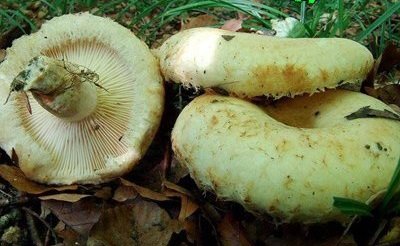
Description
Real milk mushroom (lat.Lactarius resimus) is a mushroom of the genus Millechnik (lat.Lactarius) of the russula family (lat.Russulaceae).
The hat is 5–20 cm, first flat-convex, then funnel-shaped with a pubescent edge turned inward, dense. The skin is slimy, wet, milky-white or slightly yellowish with indistinct watery concentric zones, often with adhering particles of soil and litter.
Leg 3-7 cm in height, ∅ 2-5 cm, cylindrical, smooth, white or yellowish, sometimes with yellow spots or pits, hollow.
The pulp is brittle, dense, white, with a very characteristic odor, reminiscent of the smell of fruit. Milky sap is plentiful, acrid, white, in the air it becomes sulfur-yellow.
The plates of the breast are rather frequent, wide, slightly descending along the stem, white with a yellowish tinge.
Yellowish spore powder.
In old mushrooms, the leg becomes hollow, the plates turn yellow. The color of the plates can vary from yellowish to cream. There may be brown spots on the cap.
Spreading
Milk is found in deciduous and mixed forests (birch, pine-birch, with linden undergrowth). Distributed in the northern regions of Russia, in Belarus, in the Upper and Middle Volga regions, in the Urals, in Western Siberia. It is found infrequently, but abundantly, usually grows in large groups. The optimum average daily fruiting temperature is 8-10 ° C at the soil surface. Milk mushrooms form mycorrhiza with birch. Season July - September, in the southern parts of the range (Belarus, Middle Volga region) August - September.
Similar species:
- The violin (Lactarius vellereus) has a felt cap with not pubescent edges, found most often under beeches.
- Pepper milk (Lactarius piperatus) has a smooth or slightly velvety cap, the milky juice turns olive green in the air.
- Aspen milk mushroom (Lactarius controversus) grows in damp aspen and poplar forests.
- The white boll (Lactarius pubescens) is smaller, the cap is less slimy and more fluffy.
- White podgruzdok (Russula delica) is easily distinguished by the absence of milky juice.
All these mushrooms are conditionally edible.
Remarks
In the West, it is practically unknown or considered inedible, in Russia it is traditionally considered the best conditionally edible mushroom. After removing the bitterness, it is salted, the salted mushrooms acquire a bluish tint, fleshy, juicy, and have a special aroma. It is believed that milk mushrooms are superior in calories to meat. The dry matter of the mushroom contains 32% protein. According to the Siberian method, milk mushrooms are salted along with other mushrooms (saffron milk caps, volushki). The mushrooms are soaked for one day, periodically changing the water, then washed and poured with water for another day. Salted in barrels with spices. Milk mushrooms are fit for use in 40-50 days.
In the old days, the real mushroom was considered the only mushroom suitable for pickling, it was called the "king of mushrooms". In the Kargopol district alone, up to 150 thousand poods of mushrooms and mushrooms were collected annually and exported to St. Petersburg with salted ones. A list of dishes at a dinner party on March 17, 1699 at Patriarch Adrian's is known: "... three long pies with mushrooms, two pies with milk mushrooms, cold mushrooms with horseradish, cold milk mushrooms with butter, warmed milk mushrooms with juice and butter ..." As you can see, during post, the main decoration of the table was all kinds of dishes from milk mushrooms.
Contraindications
Mushroom meals are too heavy food for people with dysfunction of the pancreas, liver and gallbladder.
The constant excessive consumption of these products, saturated with a large amount of active substances, can lead to sensitization of the body, an increase in its sensitivity, and the manifestation of allergic reactions.
The use of improperly prepared fruit bodies, especially conditionally edible species, will cause disruptions in the activity of the gastrointestinal tract and excretory system.
People suffering from hypertension and kidney disease should be careful to include in their diet spicy, salty and sour mushroom dishes, in small portions and only occasionally.Children under the age of seven and pregnant women should not eat foods made from forest mushrooms.
Children under the age of seven and pregnant women should not eat food made from forest mushrooms.
Conditionally edible aromatic lump
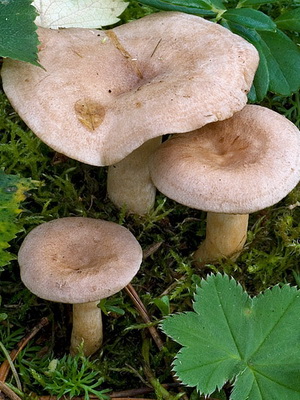
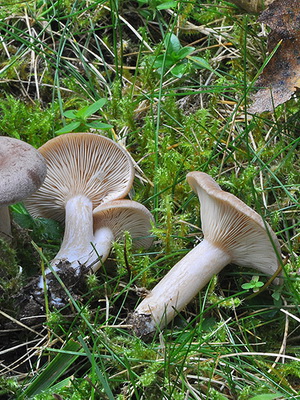
Fragrant Breasthead Hat (Lactarius glyciosmus) (diameter 4-8 cm):
pale brown or beige, may fade to light yellow. Usually funnel-shaped, in a young fungus it is flat or even convex. Dry to the touch, with slight pubescence.
Leg (height 2-7 cm):
the same color as the cap, smooth and loose, has a cylindrical shape. Older mushrooms are hollow.
Plates:
frequent and thin, beige or flesh-colored.
Pulp:
white, does not change color when cut or broken. Freshly cut mushroom smells like coconut.
Application in traditional medicine:
does not apply.
Other names:
aromatic lactarius, coconut milkman, fragrant milkman, malt, fragrant milkman.
Systematics:
- Department: Basidiomycota (Basidiomycetes)
- Subdivision: Agaricomycotina
- Class: Agaricomycetes (Agaricomycetes)
- Subclass: Incertae sedis (undefined)
- Order: Russulales
- Family: Russulaceae (Russula)
- Genus: Lactarius (Miller)
- View: Lactarius zonarius (Oak Milk)
Synonyms:
Oak lump
or, as it is also called, - oak mushroom
, outwardly very similar to all the others and differs from them only in a slightly reddish or yellowish-orange, or orange-brick color of its fruiting body. And for its generic peculiarity to grow in bushes, heaps or heaps ("milk mushrooms") in the oak forests of deciduous forests, and that was its name. The oak mushroom, like the poplar mushroom, is the main competitor and also loses to him in only one thing - in the constant presence of dirt on the surface of its cap due to the fact that the maturation of the oak mushroom, as well as the aspen and poplar mushrooms, occurs, as a rule, underground and on the surface, it appears already in its mature form. In terms of food and consumer indicators, oak mushrooms (like aspen and poplar mushrooms) belong to the second category. It is also considered conditionally edible due to the presence of a burning-bitter milky juice in its pulp, which can be attributed to the advantages of this kind of mushrooms because, due to its presence, oak mushrooms, like other mushrooms, rarely infect mushroom worms.
Oak mushrooms are quite common, but in forests rich in broad-leaved trees such as oak, beech and hornbeam. The main period of ripening and fruiting in them falls approximately in the very middle of summer and, closer to autumn, they get out to the surface, where they continue to grow and bear fruit, at least until the end of September - early October.
The oak lump belongs to lamellar mushrooms, that is, the spore powder with which it multiplies is in its plates. The plates themselves are very wide and frequent, whitish-pinkish or reddish-orange in color. Its cap is funnel-shaped, wide, concave inward, with a slightly tomentose edge, reddish or yellowish-orange-brick color. The leg is dense, even, narrowed downward and hollow inside, off-white or pinkish. Its pulp is dense, whitish or creamy. Milky juice is very spicy in taste, white in color and on the cut, when it comes into contact with air, it does not change it. Oak milk mushrooms are eaten only in salted form, after they have been preliminary and thoroughly soaked in cold water to remove the bitter taste from them. It should not be forgotten that oak milk mushrooms, just like all other milk mushrooms, are never dried.
False milk mushrooms and doubles
Conditionally edible milk mushrooms and some species similar to them are not poisonous, but have an unpleasant taste. They are successfully used in cooking after preparatory processing - prolonged soaking or boiling in slightly salted water.
Pepper milk

Pepper milk
Light mushrooms grow in clearings or rows in deciduous forests, rarely among conifers, they love dampness and thick shade. A hat with a diameter of up to 20 cm, convex or flat, then concave, creamy, with a lighter shade at the edges, brown spots quickly appear at the site of damage.
The pulp is dense, but fragile, at the break, a viscous white liquid is released, it tastes pungent, with a taste of bitter pepper. Eating is permissible in a salted form and only after prolonged soaking with frequent water changes. Dry powder from fruit bodies is used as a spicy hot seasoning.
Milk camphor (camphor milk)

Milk camphor (camphor milk)
Camphor milky often grows near conifers on moist mossy soil and on lost wood. The hat is 5–6 cm in diameter, convex, then concave, with a wavy edge, glossy, reddish-brown in color. The plates are pinkish, then brown, descend on an even thin leg up to 5 cm high, at the bottom of the tuberous shape.
The pulp is brittle, friable, brick-brown, with a very strong, rather unpleasant smell of camphor or dry sweet clover. At the break, a whitish sap is released, which does not change color in air. The characteristic smell will not allow the mushroom to be confused with others, as well as to use it for food.
Violinist (felt load)

Violinist (felt load)
In oak and birch forests from mid-summer to October, you can meet violin - a conditionally edible mushroom with a pungent taste, growing in large meadows. The white cap is fleshy, covered with villi, concave, later taking the shape of a funnel, with bent edges, up to 25 cm in diameter.The plates are creamy white, sparse, descending to a rounded stem up to 8 cm high.
The pulp is white, brittle, when broken, it emits a pungent milky-white juice. The leg is almost completely buried in the ground, so only the violin hats are collected. Before cooking, they are soaked for a long time, and then used for pickles.
Milk golden yellow (golden milky)

Milk golden yellow (golden milky)
In the dampness of coniferous or mixed forests, as well as in birch forests, one by one or in meadows, golden milky grows, attributed to conditionally edible mushrooms. The fleshy cap is light yellow, darkens and becomes purple at the points of contact, the velvety edges are bent down. The form is outstretched, then concave, the surface is sticky. The plates are yellowish, frequent, descending to a pale yellow high leg.
The pulp is creamy white, emitting a caustic liquid of milky color, with a pleasant odor. Suitable for pickles and making marinades after soaking or boiling.
Growing at home and in the country
Milk mushrooms are very capricious mushrooms, and therefore it will be quite difficult to grow them at home, but it is quite possible. Self-preparation and collection of mycelium, most likely, will not give the desired result, and therefore it is better to resort to buying ready-made material. Be sure to have one of the favorite mushroom trees on the site - an oak. You can use beech or hazel.
Preparing the substrate for planting the mycelium is easy:
- Take sawdust (it is better if they come from oak or beech) and sterilize them in a water bath.
- Find moss in the forest, tear it into small pieces.
- Collect fallen leaves from your favorite oak bean trees.
- Mix sterile soil with prepared sawdust.
- Dig a wide strip 10-15 cm deep near the tree, preferably closer to the roots.
- Fill the space with the prepared composition.
First, only half the depth of the trench is poured, then the mycelium is laid out, then the remaining substrate is tamped. From above, everything is covered with pre-brought moss and foliage.
The best time for planting will be summer, more precisely, the entire period from spring to autumn. Watering will be required regular and abundant. If necessary, and during extreme heat, the place where the mycelium is planted is covered to retain more moisture. A year later, the harvest will ripen, and such a mycelium bears fruit for about five years.
Milk camphor (camphor milk)
Camphor milky often grows near conifers on moist mossy soil and on lost wood.The hat is 5–6 cm in diameter, convex, then concave, with a wavy edge, glossy, reddish-brown in color. The plates are pinkish, then brown, descend on an even thin leg up to 5 cm high, at the bottom of the tuberous shape. The pulp is brittle, friable, brick-brown, with a very strong, rather unpleasant smell of camphor or dry sweet clover. At the break, a whitish sap is released, which does not change color in air. The characteristic smell will not allow the mushroom to be confused with others, as well as to use it for food.
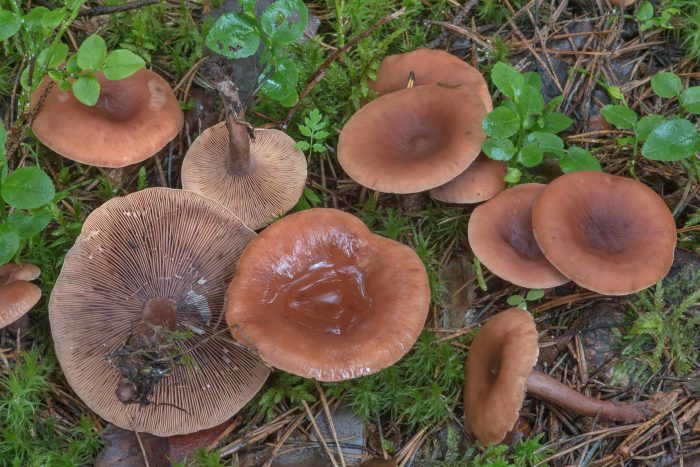 Camphor milk
Camphor milk
The main types of mushrooms
Real Milk (Lactarius resimus)

Real Milk (Lactarius resimus)
The most famous species with excellent taste. The cap is fleshy, at first spread out, and then depressed in the center, with curved fringed edges, reaching a diameter of 20 cm. The skin is milky or with a yellow tint, sometimes with reddish spots, slimy in rainy or foggy weather.
The leg is even, up to 6 cm high, frequent creamy white plates descend onto it. The pulp is tight, white, with acrid juice, yellowing at the break. This is the best type for pickles in which the fruiting bodies take on a light blue tint.
Aspen Milk (Lactarius controversus)
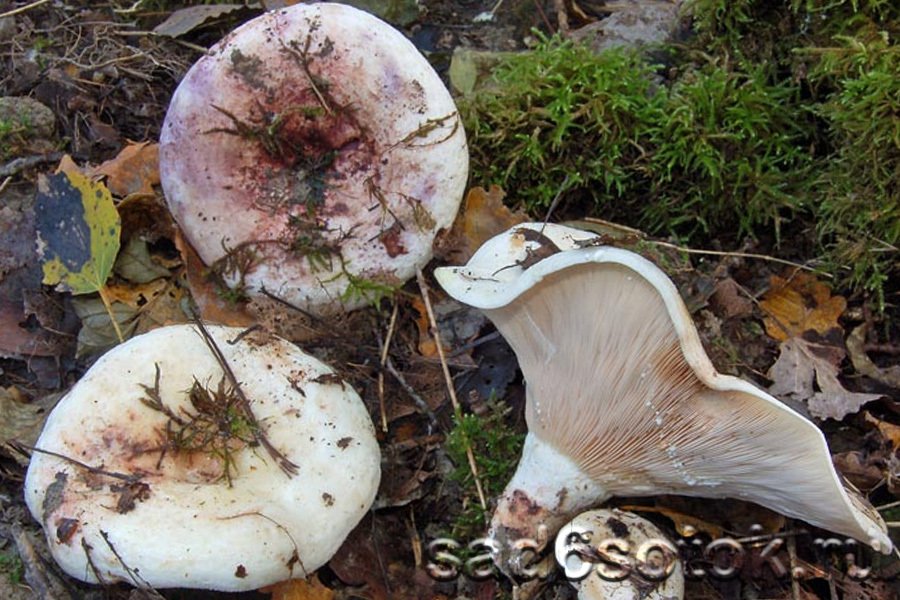
Aspen Milk (Lactarius controversus)
The cap is initially flat-rounded, raised in the center, later concave, up to 30 cm in diameter, white, with reddish or purple streaks, slightly pubescent. The plates are frequent, white with a pink glow, descending to a dense stalk up to 8 cm high, which becomes narrower at the base. The pink hue of the plates is the main difference between this species and other milkers.
The pulp is milky-white, with a fruity aroma; when broken, it emits a caustic white liquid that does not darken in air.
Yellow Milk (Lactarius scrobiculatus)

Yellow Milk (Lactarius scrobiculatus)
A beautiful mushroom, with an appetizing golden cap up to 15 cm in diameter, concave in the center and fringed at the edges, slimy in rain and glossy on a sunny day. The leg is strong, small, up to 5 cm tall, with a yellowish tinge and patterned golden stains or spots.
Often located creamy plates descend to the stem. The pulp is juicy, burning juice appears on the fracture, which then darkens. Darkening may appear during collection and transportation at touch points.
Oak Milk (Lactarius insulsus)

Oak Milk (Lactarius insulsus)
The cap is open, then funnel-shaped with the edges turned down, up to 12 cm in diameter. The skin is brown-orange, with a reddish tint, covered with brown spots. Yellowish plates descend to a peduncle of the same color.
The pulp is fleshy, creamy white, when broken, it acquires a pink tint and releases a watery white liquid with a pungent taste and a slight mushroom odor. The mushroom is used for pickling and is considered conditionally edible.
In another way, oak mushroom is called oak mushroom. If you are interested in learning more about saffron milk caps, read the article "Camelina mushrooms".
Black Milk (Lactarius necator)
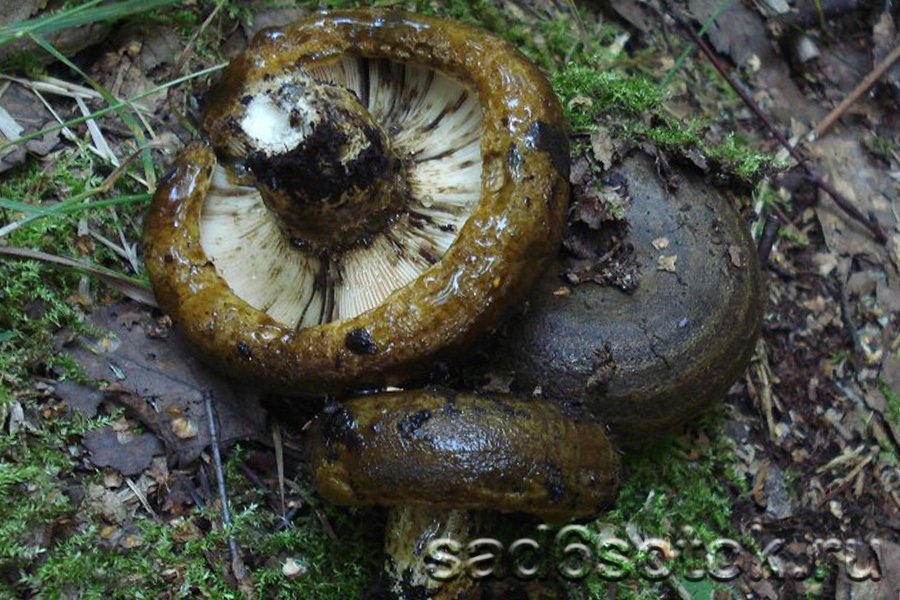
Black Milk (Lactarius necator)
This dark mushroom is very tasty in pickles, acquiring a wine, reddish tint. The cap is round-flat, later sunken, up to 20 cm in diameter, brownish yellow with an olive tint or dark green, the surface may be covered with concentric circles. The edges are curved, slightly fringed. The skin is slimy, especially in rainy weather.
Greenish sticky leg up to 8 cm high, tight and full, becomes hollow towards the base, the surface is covered with dents. In the upper part, thinned plates of a yellowish-olive color descend on it. The white flesh is fleshy, grayish when broken, emitting a milky liquid, which in the air acquires a lilac hue. The hat is often dirty, the surface is covered with soil particles and debris, and must be scraped before cooking.
White podgruzdok (dry lump) (Russula delica)

White podgruzdok (Russula delica)
White podgruzdok - a tasty and fragrant type of russula, a whitish-cream hat with brown stains, up to 20 cm in diameter, rounded-convex, and then concave. The plates are frequent, creamy white, falling on an even or slightly curved strong stem.The pulp is tight, creamy, with a delicate mushroom aroma and a pungent taste.
The surface is usually covered with ingrown soil particles. In dry weather, dry fabrics can crack like parchment, which is why the load got its second name.

